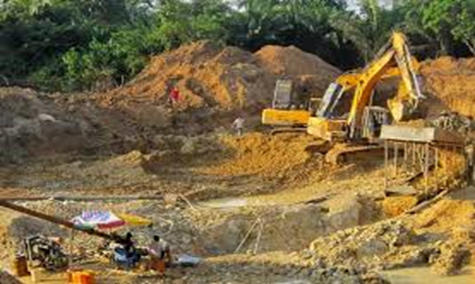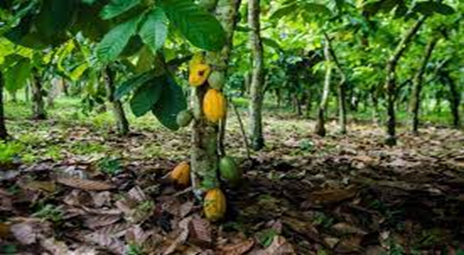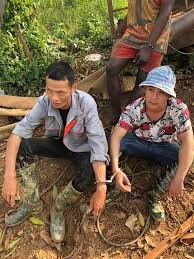
Galamsey sites
China’s involvement in Ghana’s galamsey (illegal small-scale mining) has been a significant and contentious issue, drawing attention due to its implications for the environment, local communities, and international relations. Galamsey refers to informal or illegal mining operations, primarily focused on the extraction of gold.
This practice has been prevalent in Ghana for decades and has gained attention due to its environmental and social impacts. Many Ghanaians engage in galamsey for economic reasons, particularly when formal job opportunities are scarce. It offers a fast track to income, often involving both local and foreign participants.

Cocoa farms used for galamsey
In the lush landscapes of Ghana, a silent battle is being fought as farmers increasingly relinquish their agricultural lands to engage in small-scale mining, popularly known as galamsey. This economic shift is driven by the urgent need for financial stability amidst rising poverty levels and inadequate support for sustainable farming practices.
For many farmers in Ghana, the dwindling returns from traditional farming, exacerbated by climate change and soil degradation, have made galamsey an attractive alternative. The promise of quick financial gain lures individuals away from the fields they have tended for generations. “With cocoa and maize prices falling, and the cost of living rising, mining seems like the only viable option to provide for my family,” lamented Kwame, a local farmer who recently transitioned to mining
However, this shift does not come without significant consequences. The allure of immediate cash often leads to over-extraction of resources, resulting in devastating environmental degradation, including deforestation, soil erosion, and the contamination of water sources. These practices disrupt local ecosystems and pose risks not only to the community’s health but also to the viability of future agricultural endeavors.
The environmental impact of galamsey is pervasive. Agricultural lands are left barren and unproductive, disrupting food security in a region that heavily relies on farming. The loss of arable land also threatens the livelihood of those who depend on agriculture, creating a vicious cycle of poverty and environmental destruction.

Over the years, a significant number of Chinese nationals have moved to Ghana, attracted by the prospects of gold mining. Their involvement has led to the establishment of Chinese-led mining operations that often operate in conjunction with local miners. Chinese investors have provided capital and technology to support mining activities, frequently setting up partnerships with local miners. This influx has often resulted in expanded mining operations beyond legal limits.
Chinese-operated illegal mining has led to widespread deforestation, water pollution (due to the use of toxic chemicals like mercury and cyanide), and soil degradation, exacerbating existing environmental challenges in the area. The involvement of Chinese miners has sometimes led to tensions with local communities over land use rights, as mining operations encroach on agricultural lands, leading to disputes and resentment among local farmers.
The Ghanaian government has implemented various measures to curb illegal mining activities, particularly targeting Chinese operations. For example, in 2017, the government initiated a ban on all small-scale mining while it assessed the situation. This military-led task force was deployed to combat illegal mining activities and enforce the law, including deportation of illegal foreign miners, particularly Chinese nationals, found operating without licenses.
The involvement of Chinese miners has caused tensions between Ghana and China, particularly when illegal activities lead to the detention or deportation of Chinese nationals. Such incidents have sometimes strained diplomatic relations. Although Chinese involvement in mining can boost local economies, the overall impact on sustainable development and the consequences of environmental degradation have led to calls for a more regulated approach to foreign investment.
In response to the challenges posed by foreign involvement in galamsey, Ghana has looked towards strengthening its regulatory framework. This includes improved licensing and oversight mechanisms for mining operations. Ghana has also voiced interest in attracting responsible foreign investment that supports sustainable mining practices, urging investors to adhere to environmental regulations.

To combat these adverse effects, a shift towards regenerative agriculture presents a promising reclamation strategy. This holistic approach focuses on restoring soil health, enhancing biodiversity, and improving water retention—all critical factors in reversing the damage caused by galamsey activities.
Regenerative agriculture includes practices such as cover cropping, crop rotation, and agroforestry, which can help restore soil fertility and sequester carbon in the soil. Assessing a site’s unique characteristics allows for tailored strategies that can significantly enhance productivity while also protecting the environment.
Local extension services and agricultural organizations can play a pivotal role in this transition. By providing education and resources, they can empower farmers to adopt regenerative practices. Workshops on composting, natural pest management, and organic farming techniques can equip farmers with the skills needed to restore their lands and improve crop yields.
Furthermore, initiatives that incentivize farmers to engage in sustainable practices can create a viable alternative to galamsey. By promoting eco-tourism or the cultivation of high-value organic crops, communities can unlock new income sources while preserving their environment.
As farmers grapple with economic pressures, understandable choices lead them to engage in destructive practices like galamsey. However, through the adoption of regenerative agriculture, there lies hope for recovery and restoration—both of the land and the livelihoods of those who depend on it. A collective effort involving local communities, government agencies, and non-profits will be essential in forging a sustainable path forward that honors both the land and the people who call it home.
As communities work together to reclaim their lands and cultivate a greener future, the potential for regeneration lies not just in the soil but within the hearts and hands of the farmers themselves.



